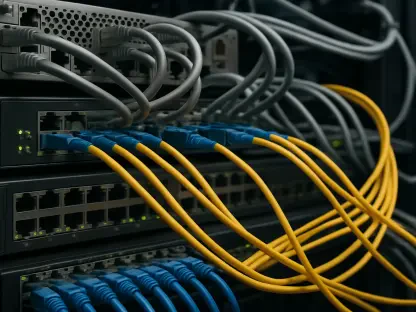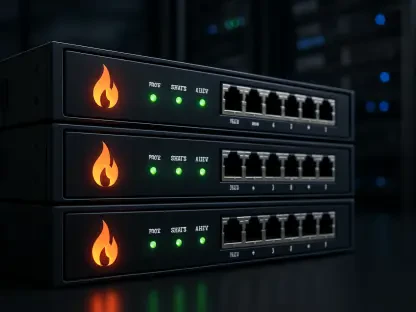Matilda Bailey’s expertise in networking and her focus on cellular, wireless, and next-gen solutions make her exceptionally qualified to analyze NVIDIA’s latest technological advancements announced at Computex 2025. Her insights will help us understand the transformative impact of these innovations on AI and networking infrastructure.
Can you discuss the key themes and innovations highlighted during Jensen Huang’s keynote at Computex 2025?
Jensen Huang showcased NVIDIA’s commitment to revolutionizing AI infrastructure. He emphasized the concept of AI as a new type of infrastructure that requires factory-like environments for production, akin to the transformative forces of electricity and the internet. This keynote underscored NVIDIA’s strategic focus on scalable AI factory solutions, which are distinct from traditional data centers. Huang highlighted several new products aimed at pushing AI innovation forward by speeding up and expanding computational capacity.
How does Jensen Huang perceive AI’s role in today’s world as described in his keynote?
Huang views AI as a pivotal force reshaping various aspects of our lives and industries. He passionately described AI’s potential to revolutionize infrastructures much like previous technological leaps. His talk reflected an optimistic belief in AI’s ability to generate immense value through new factory-style setups, where advanced computation and connectivity lead to unprecedented production capabilities.
What is NVIDIA’s definition of “AI infrastructure,” and how does it compare to traditional data centers?
NVIDIA’s notion of “AI infrastructure” marks a departure from conventional data centers. AI infrastructure involves high-performing computational environments designed to facilitate large-scale AI processes efficiently. Unlike traditional setups, these new infrastructures aim to support and leverage AI-specific workloads by employing advanced technologies to optimize data flow and processing speeds, thereby fostering transformative AI development.
Could you explain NVLink Fusion and its significance in scaling AI systems?
NVLink Fusion serves as a breakthrough in overcoming current limitations in AI scalability. It enhances the connectivity between GPUs and systems by providing a more reliable, faster network backbone. This innovation is crucial because it allows the integration of enormous numbers of GPUs into custom rack-scale designs, which are essential for handling the ever-growing data demands of modern AI applications.
What challenges in AI scalability and data flow does NVLink Fusion address?
NVLink Fusion addresses key bottlenecks in AI scalability related to data flow efficiency. Traditional networks struggle with the immense demands of AI applications, often hindering performance. NVLink Fusion’s design significantly enhances throughput and reliability, supporting the seamless operation of vast AI systems requiring rapid data exchange.
How does NVLink Fusion enable custom rack-scale designs, and what are the benefits for enterprises using third-party CPUs and accelerators?
By connecting multiple servers on a single backbone, NVLink Fusion empowers enterprises to create tailored rack-scale designs. This flexibility allows the integration of various third-party CPUs and accelerators along with NVIDIA systems, which enhances customization capabilities. For enterprises, this means greater efficiency and performance in deploying sophisticated AI infrastructures without being confined to using solely proprietary products.
Can you outline the capabilities and features of NVIDIA’s Blackwell architecture?
The Blackwell architecture underpins NVIDIA’s latest AI offerings, providing a versatile platform for cloud, enterprise, personal, and edge AI applications. With its innovative design, Blackwell delivers substantial computational power that supports a wide range of AI operations. Featured in products like DGX Spark, Blackwell optimizes performance across varied workloads, offering an adaptable solution to meet diverse AI needs.
What is the significance of the DGX Spark, and how does it differ from the DGX-1 introduced in 2016?
DGX Spark symbolizes a leap forward in personal supercomputing, providing users with greater accessibility and versatility. Unlike the original DGX-1, DGX Spark is equipped with cutting-edge NVIDIA GB10 Grace Blackwell Superchip technology, offering superior computational capability and unified memory. It’s designed to deliver high performance for demanding AI workloads, right from an ordinary power outlet, making it easier for individuals to access supercomputer-like processing power.
Which computer manufacturers will offer the DGX Spark, and what are its key specifications?
The DGX Spark will be available through major manufacturers including Dell, HP, ASUS, Gigabyte, MSI, and Lenovo. It maximizes computing strength with up to 1 petaflop of AI compute and 128 GB of unified memory. This integration highlights collaboration across industry leaders, broadening accessibility to high-performance computing for AI enthusiasts and professionals alike.
How does the DGX Station compare in performance to other AI computing solutions?
The DGX Station stands out in AI performance, particularly with its ability to handle a 1 trillion parameter AI model thanks to the NVIDIA Grace Blackwell Ultra Desktop Superchip. With 20 petaflops and 784 GB system memory, it offers unparalleled capacity for intensive AI workloads. Compared to other solutions, the DGX Station provides exceptional computing power tailored to the most demanding AI processes.
Tell us more about NVIDIA’s new RTX PRO line of enterprise and omniverse servers. What purpose do they serve?
The RTX PRO servers function as a foundation for constructing sophisticated on-premises AI factories. Their purpose is to facilitate agentic AI processing, enabling partners to build environments conducive to advanced AI model development. As integral components of NVIDIA’s Enterprise AI Factory design, these servers provide robust infrastructure to support cutting-edge AI endeavors.
How do NVIDIA’s RTX PRO servers contribute to on-premises AI factory designs?
RTX PRO servers offer enterprises a sturdy and scalable foundation for deploying AI factories on-premises. By integrating NVIDIA’s advanced GPUs with networking capabilities, these servers enhance data processing capacity and efficiency. They play a key role in ensuring reliable, high-performance environments where complex AI computing can thrive.
What advancements in storage technology are required for modern AI compute platforms, according to NVIDIA?
Modern AI compute platforms demand innovative storage solutions to manage enormous data efficiently. NVIDIA partners are working on intelligent storage infrastructures, utilizing RTX PRO 6000 Blackwell Server Edition GPUs and AI Data Platform designs, ensuring performance stability and capacity to handle unprecedented data loads essential for advanced AI operations.
Can you discuss NVIDIA’s focus on robotics and the introduction of Isaac GROOT N1.5?
NVIDIA is committed to pioneering advancements in robotics, exemplified by the Isaac GROOT N1.5 update. This iteration offers a customizable, open model foundation for humanoid reasoning and skills development. It’s instrumental in training robots to adapt to diverse environments, marking significant progress in real-world AI practical applications.
What is the Isaac GROOT-Dreams blueprint, and how does it aid physical AI developers?
The Isaac GROOT-Dreams blueprint facilitates the generation of synthetic motion data for AI developers. Known as neural trajectories, these data sets are pivotal for training robots to exhibit new behaviors and adapt to changing conditions. This blueprint supports developers in enhancing robot functionalities through advanced motion simulations.
How does NVIDIA maintain its competitive edge in the rapidly evolving technology landscape according to the keynote?
NVIDIA’s relentless pursuit of innovation sustains its competitive advantage. By continuously advancing hardware capabilities and fostering partnerships across industries, NVIDIA keeps its footing at the forefront of technological development. Huang’s keynote highlights a clear strategy for future growth, propelled by cutting-edge products and thoughtful infrastructure designs.
As an industry analyst, how do you perceive the impact of NVIDIA’s latest announcements on the broader AI and tech industry?
NVIDIA’s latest announcements signal a progressive shift towards more efficient and powerful AI infrastructure, influencing industry standards. These innovations will likely accelerate AI adoption across sectors, driving competition and inspiring further technological breakthroughs. NVIDIA’s leadership role catalyzes broader change, shaping the future landscape of AI and beyond.









